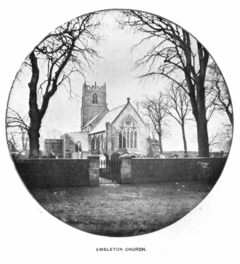Robert de Emeldon
Robert de Emeldon (died 1355) was an English-born Crown official and judge who spent much of his career in Ireland. He held several important public offices, including Lord High Treasurer of Ireland and Chief Baron of the Irish Exchequer .[1] He was a turbulent and violent man, who was guilty of at least at least one (and probably two or more) homicides, and was later imprisoned for a number of serious crimes: but he was a favourite of King Edward III and was thus able to survive any temporary disgrace.[2]
Early career

He took his name from his birthplace, Embleton, Northumberland.[3] He also had links with Newcastle-upon-Tyne, and he is thought to have been a cousin of Richard de Emeldon, who was Mayor of Newcastle in the early years of Edward III's reign, and is thought to have moved there from Embleton. He became parish priest of Lesbury, Northumberland in 1329.[4]
He was an official in the English Chancery for many years: Gilbert states that he was a great favourite of Edward III, who had known him since childhood.[5] He came to Ireland about 1335 and became prebendary in the Diocese of Clonfert.
Homicide
The Patent Rolls have a terse entry for 18 January 1336:
Pardon to Robert of Emeldon in consideration for his services to the King in Ireland for the death of Ralph de Byrton, knight, and of any consequent outlawries.[6]
No further details of the crime or the victim are given, although the list of charges brought against Embledon in 1350 included at least one charge of manslaughter.
Later career
In 1340, Emeldon became Chancellor of the Exchequer of Ireland. He was appointed Treasurer of Connacht in 1341, and was specially entrusted with the task of receiving on the Crown's behalf the profits of all lands in Connacht held by the late William Donn de Burgh, 3rd Earl of Ulster, who had been murdered in 1333, which he held as tenant- in-chief from the King.[7]
He was made Lord High Treasurer in 1348.[8] The vacancy in the Lord Treasurer's office arose from charges of corruption and negligence, which ultimately proved to be groundless, made against Emeldon's predecessor, John de Burnham, who was required to spend several years in England clearing his name. The main instigator of the charges was William de Barton, a disgruntled former official at the Exchequer of Ireland. Emeldon, unlike Barton, benefited directly from Burnham's long absence from Ireland, and it is possible that he was also involved in the accusations against Burnham.[9]
In 1350 the new Lord Lieutenant of Ireland, Sir Thomas de Rokeby, launched a campaign against corrupt officials, and this was undoubtedly the reason for his imprisonment of Emeldon.[10] In Emeldon's case "corruption" seems to have meant not financial mismanagement in the usual sense, but rather a record of crimes of violence, including assault, rape, robbery and manslaughter.[11] Since Emeldon, instead of protesting his innocence, pleaded benefit of clergy it is likely enough that the charges were true; he had of course already been pardoned for killing Ralph de Byrton in 1336.
No doubt due to the favour he enjoyed with the King, Emeldon was soon released from prison and received a second royal pardon, despite Rokeby's protests. He became Chief Baron in 1351 and died in office in 1355.[12]
References
- Ball, F. Elrington The Judges in Ireland 1221-1921 John Murray London 1926 Vol.1 p.80
- Gilbert, Sir John History of the Viceroys of Ireland Dublin J. Duffy and Co. 1865 p.205
- Ball p.80
- Ball p.80
- Gilbert p.205
- Patent Rolls Edward III Vol.3 p.194
- Close Roll 15 Edward III 21 November 1341
- Ball p.80
- Connolly, Philomena The Proceedings against John de Burnham Treasurer of Ireland 1343-1349 : "Essays Presented to J F Lydon Cambridge University Press 1993 p.72
- Gilbert p.205
- Connolly p.63
- Ball p.80
- Secondary Sources
- Connolly, Philomena (1993). "The Proceedings against John de Burnham Treasurer of Ireland 1343-1349". Essays Presented to J F Lydon. Cambridge University Press: 72.
- Ball, F. Elrington (1926). The Judges in Ireland 1221-1921. Vol.1. London: John Murray. p. 80.
- Gilbert, Sir John (1865). History of the Viceroys of Ireland. Dublin: J. Duffy and Co. p. 205.
- "Patent Rolls Edward III". Vol.3: 194. Cite journal requires
|journal=(help)